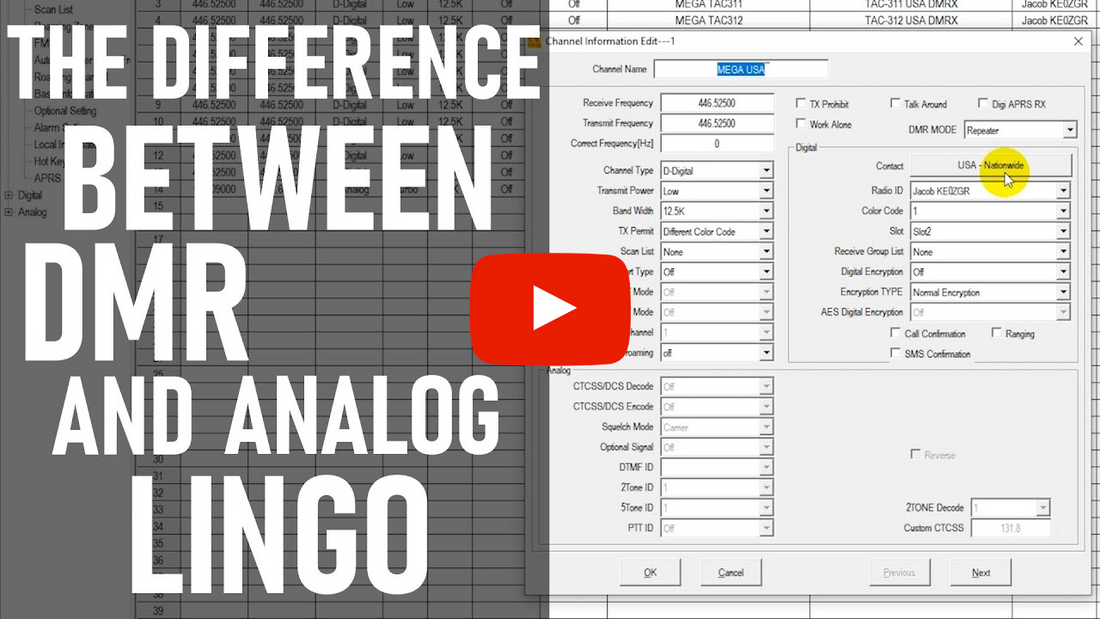
Translating Analog Terms to DMR
Don't continue banging your head against the wall trying to figure out the language of DMR. We've got the hack to DMR lingo!
Sebastian, KBØTTL, gives the breakdown to all confusing DMR terminology below.
View our Radios - https://bit.ly/2wvW9oi
Want to stay updated on all things BridgeCom Systems? Click the links below to join our Offical Facebook Group and subscribe to our YouTube channel.
Transcript:
- Hi, this is Sebastian KBØTTL. Today we'll be going over the differences in terminology between DMR terms and analog terms. On your AnyTone 868, 878, and 578 Radio. For the majority of this, we're going to be going over to the computer as I'm going to be showing you the various screens for programming and going over the terminology.
I was just going to go over the differences between the lingo dealing with analog channels and digital channels as far as amateur radio terms are concerned. So, first of all, I'm going to look at an analog channel, which I'm sure most of you have already seen on other, simpler radios back from a simpler day. We have the transmit and receive here, So this is a repeater out in independence, Missouri on a receive frequency of 147.690 transmit frequency of 147.690, this is a duplex frequency of course frequency pair versus a simplex frequency pair. We're gonna have this set for analog. We want the highest power available. And then we have a bandwidth of 25kHz. This repeater does not use CTCSS however, if it did, we could select a CTCSS setting from here as well. CTCSS were sub-audible tone which is an edited security feature for a lot of repeaters. Just basically keeping people that aren't necessarily familiar with ham radio operation from kerchunking or interfering with the repeater. So unless the sub-audible tone or CTCSS Tone on your radio matches the one they have on their repeater, he won't be able to access it. So it's a little bit of an extra security precaution.
So of course when you go to transmit on frequency repeater and everybody be able to hear what you're saying on Again, this is analog. This is not with the digital signal. Now looking over to one of the digital channels, the lingo changes here slightly. It is how all of these frequencies here are simplex. So basically this is set up for a hotspot. You can use a duplex frequency on a digital repeater or a simplex frequency on a digital hotspot. So here's a slight difference though, we're gonna have the set for digital. The bandwidth is actually narrow band on a DMR or digital repeater. We're going to use something called the color code instead of a CTCSS. Color code is something that the sys op on each repeater can set and it's a basically CTCSS except for digital meaning unless the color code that you're transmitting on matches the color code of the digital repeater, you're not going to be able to gain access so we're looking at color code selective low from code one or actually zero rather zero through 15 color code.
There's also a time slot, on each digital repeater. You're capable of having two conversations taking place on that same repeater at one time, one on time slot one and one on time slot two as digital streams are concerned. Keep in mind most repeaters have designated one of the time slots for normal repeater traffic and the other time slot for talk groups for DMR talk group access. And it's best not to get those two confused. As the sys op of the repeater can actually have your DMR ID number banned from a repeater if you're using the wrong time slot. So make sure that if you're supposed to be talking, net roofs and things of that nature only on time slot one, that's all you're using time slot one for a vice versa if it's time slot two, but the other time slot is typically open on said repeaters, for use for digital communications on the talk groups. So there you have some of the differences here between analog and digital.
Also, you're gonna need to select your talk group. You most likely upload a talk group list from Brandmeister. And these are all the talk groups that we currently have available, loaded into this radio. So you're gonna select which talk group that you want to talk on. You're gonna select a talk group for each channel on digital. So say you're talking on a digital repeater, you're programming a digital repeater into your radio. You're actually going to put a separate channel. And even though the frequency pair is the same, you're going to put a different talk group in for each channel that is for each talk group that you wanna use while you're on that repeater. Unlike the analog repeater where you just plug your frequency pair in one time and you're good to go. When talk groups are involved, you're going to do a different channel for each talk group on the same frequency pair. So these are the differences between programming analog and digital channels and some of the lingo, that you'll hear being used on the DMR repeaters. And if you have a hotspot on your hotspot as well, which color code are you on? which talk group are you on? And also which time slot are you on? And there we have it.
Again. My name is Sebastian KBZØTTL. Thank you for watching. If you like today's video, be sure to like us on Facebook and subscribe to our YouTube channel, 73.









3 comments
The image at the top of this article indicates there is a video but it’s just an image.
Hi. I’M having problems viewing this video. it will post ok on my email but when i go to view the video it wont start. what can i do to view it?
thanks
RICH BEREZANICH
From above
“ So this is a repeater out in independence, Missouri on a receive frequency of 147.690 transmit frequency of 147.690, this is a duplex frequency of course frequency pair versus a simplex frequency pair. ”
I believe you need to correct this.